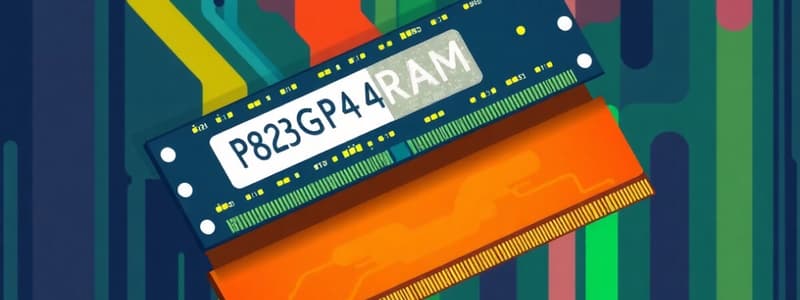Podcast
Questions and Answers
What is the primary function of read-only memory (ROM) in a computer?
What is the primary function of read-only memory (ROM) in a computer?
- To store data and instructions for booting the computer (correct)
- To increase the speed of data processing
- To provide temporary storage for running applications
- To allow users to modify and delete stored data
Which of the following statements about RAM is accurate?
Which of the following statements about RAM is accurate?
- RAM can be easily replaced with read-only memory for cost saving.
- RAM is nonvolatile, retaining data when the power is turned off.
- RAM is a major factor impacting the final cost of a computer. (correct)
- RAM storage capacity for professionals in 2019 can only reach up to 4 GB.
What distinguishes erasable programmable ROM (EPROM) from programmable ROM (PROM)?
What distinguishes erasable programmable ROM (EPROM) from programmable ROM (PROM)?
- EPROM is inherently slower in data retrieval than PROM.
- EPROM is used strictly for booting processes, while PROM is used for application storage.
- EPROM allows data to be deleted and reprogrammed, whereas PROM cannot be modified after its initial programming. (correct)
- EPROM can only be programmed once, while PROM can be reprogrammed multiple times.
Which of the following best describes secondary storage?
Which of the following best describes secondary storage?
Which of the following types of storage is classified as secondary storage?
Which of the following types of storage is classified as secondary storage?
What is the primary function of the control unit (CU) within the CPU?
What is the primary function of the control unit (CU) within the CPU?
Which type of memory is classified as volatile and loses its data when the power is turned off?
Which type of memory is classified as volatile and loses its data when the power is turned off?
What are the two main types of memory chips found in primary storage?
What are the two main types of memory chips found in primary storage?
When a computer is turned on, where is the data and instructions that the CPU processes immediately stored?
When a computer is turned on, where is the data and instructions that the CPU processes immediately stored?
What role does RAM play in the processing of applications like word processors or spreadsheets?
What role does RAM play in the processing of applications like word processors or spreadsheets?
Why must data be loaded into RAM before it can be processed by the CPU?
Why must data be loaded into RAM before it can be processed by the CPU?
What is a key characteristic of Read-Only Memory (ROM)?
What is a key characteristic of Read-Only Memory (ROM)?
Which statement about primary storage is TRUE?
Which statement about primary storage is TRUE?
Flashcards are hidden until you start studying
Study Notes
Primary Storage
- Primary storage is directly accessible to the CPU and holds data and instructions being processed.
- Also known as main memory or immediate access store (IMAS).
- Located on the motherboard and consists of RAM and ROM chips.
Random-access memory (RAM)
- Filled after a computer is turned on and given a task.
- Holds data and instructions temporarily during processing.
- Also holds processed data waiting to be output or stored in secondary storage.
- Known as working memory.
- Programs and data from secondary storage must be loaded into RAM before processing.
- Volatile, meaning data is lost when power is turned off or the computer is rebooted.
- Limited storage capacity, ranging from 4 GB to 32 GB in 2019.
- Expensive and significantly affects the price of a computer.
Read-only memory (ROM)
- Stores data and instructions needed for starting up the computer.
- Commonly used for system level programs like BIOS.
- May also hold translators for high-level languages and operating systems.
- Instructions are fixed at manufacture and considered hard-wired.
- Nonvolatile, data remains even when the power is off.
- Crucial for initial startup as system memory is empty.
- Variations include PROM and EPROM, offering some flexibility in data storage.
Secondary Storage
- Also known as auxiliary or backup storage.
- Used to store data and instructions when not being processed.
- More permanent than main memory, data is retained after power off.
- Cheaper and has unlimited storage capacity compared to primary storage.
- Common devices include magnetic disks, optical disks, flash memory, USB drives, and magnetic tapes.
Studying That Suits You
Use AI to generate personalized quizzes and flashcards to suit your learning preferences.




